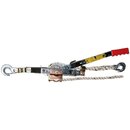Would the trash bag filled with water on land rip? If the answer yes then it will rip as a lifting bag under water as the forces involved are identical.
Dump valves on lifting bags are NOT for controlling the ascent of the object. Objects don't get bent, divers do. The dump valve is for removing/repositioning the object/bag.
The correct way to control a lift is to tailor the volume of your lifting bags so that they are full with the object just positively buoyant, expanding air will spill from the bottom of the bags and keep the ascent rate constant.
If you need more control than that then have fewer bags filled to the brim so the object is still negatively buoyant and provide the last lifting effort with a winch or even
manpower hauling on a rope. Again, it won't run away because the bags are full and expanding air will spill from the bottom of them. You can add sealed pontoons or barrels to secure everything from sinking again once the object is at the surface.
It is much better to use 5kg too little lift but all full bags and haul to overcome the 5kg than to have too much bag capacity into which air can expand and cause a runaway.
If you need to apply excess lifting force to break an object free of the bottom suction then attach the break out bag to the object by ropes/slings long enough so that the bag itself is just under the surface of the water. Then, when it breaks free, the whole lot will only travel the distance the bag was underwater. You can then tow it a short distance so it doesn't settle back in its own hole, deflate the bag (using the dump valve for its intended purpose), lowering the object back onto the seabed for lifting as normal. This avoids dangerous/silly situations like shackles breaking and sending bags into the air or the object breaking free of the bottom and then accelerating all the way to the surface under grossly excessive and uncontrolled lift.
Finally, if someone tasks you with controlling an ascending lifting bag by ascending with it and operating the dump valve, tell them to go away and come up with a safe scheme of work or to do it themselves if they think it is a safe idea.







